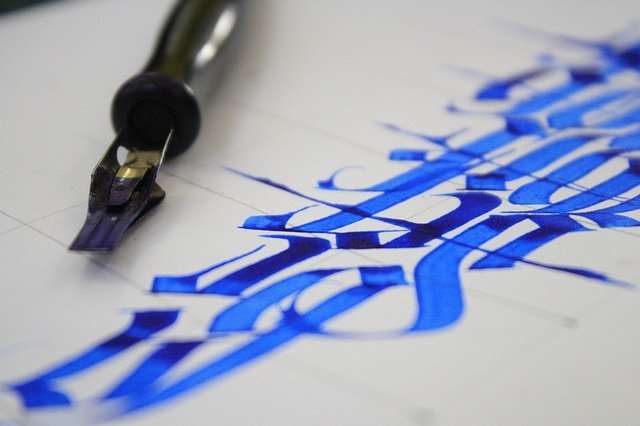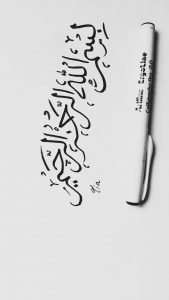Handwriting is an art, which can be expressed using different styles. The process of practicing simple yet beautiful handwriting not only makes you proficient in writing but also increases the aesthetic sense. Calligraphy and its beautiful handwriting is one of the most interesting and unique ways to create a beautiful and professional handwritten look
Table of Contents
Penmanship is an art
A century ago, handwriting was a widespread skill, practiced by nearly every literate person. Now, it is a lost art. But as with most arts and crafts, as soon as you take it up again, you realize how much of it there was to know.
It’s not just learning to form letters. There are many specific kinds of letters to know—gothic versus italic versus copperplate versus Spencerian versus this or that commercial script.
There are different pens for different kinds of strokes—brush pens for calligraphy, pointed pens for Spencerian, felt-tip markers for commercial scripts.
Then there are decisions about which ink to use—waterproof ink for making checks, colored inks for decorating the envelopes you write on, black India ink for formal occasions.
Another thing that people who have tried cursive writing lately discover is how much there is to control besides your hand.
How hard do you press on the paper? What angle does your wrist make with the page? How fast do you move? Are you sitting upright or slouching over the paper? Are you trying to make everything uniform or are you going freestyle?
The important thing is to get used to the idea that good handwriting is not just printing. It’s something creative, an art form in itself.
We live in a digital age. Any time you write something out by hand, you are resisting the trend toward digitization, and asserting your individuality—in a small but significant way. You are applying the brakes to the rush toward conformity.
First impressions are everything
First impressions matter because they’re hard to change: they tend to sink in quickly and become self-confirming. If people think they know you based on your writing style, it’s hard to change their minds later on when they realize they were wrong about you in some particular way. And they might not realize their mistake even when they make it.
The handwriting is the signature of the soul, so if you want to know what a man is like, look at his handwriting.
The signature of a person’s soul can be hard to detect in conversation or e-mail. If you really want to know someone, you might try asking them to write something out.
The first impression of a handwritten page is very different from the first impression of a typed one. The handwriting tells you: here is a real, live person.
When we read, we want to meet people. We want to be part of their story. We want to know what they think and how they feel and why they made the choices they did. When we get lost in a book, it feels like we’re having a conversation with the author.
What makes handwriting beautiful?
The secret to beautiful handwriting is to make the writing itself beautiful, which is to say readable. That may seem obvious enough, but it isn’t.
The guiding principle (it’s not a rule) of good handwriting is this: don’t do anything that interferes with readability.
You can make it as fancy as you like, as long as you spell everything correctly and don’t confuse one letter for another. There is no such thing as decorative handwriting; there is only bad (hard to read) and good (readable) handwriting.
It’s not just having the right letters, although that helps. It is also spacing them properly, making the lines and words look nice on the page, and even making sure that your pen is moving at a good speed. One of the best ways to write more beautifully is to slow down.
It’s hard to write beautifully quickly, because it is a skill involving a lot of unconscious decisions. You have to know how big a letter needs to be on each line, and whether you should start that line at the top or bottom of the page, and how much space there needs to be between lines. If your pen moves too quickly for you to make those decisions, your handwriting will become ugly. This is one of those areas where practice doesn’t make perfect — if anything, it makes worse.
It’s surprisingly hard to teach people how to manage these decisions correctly. I asked several people who had been paid to teach handwriting why my handwriting still looks ugly; they didn’t seem to know what I was talking about. But if you pay careful attention as you write, pausing every few minutes and looking at what you’ve done so far, you can learn enough about how beautiful writing works that your own handwriting will improve.
Tips to achieve gorgeous cursive handwriting
Calligraphy is the art of beautiful handwriting, and learning calligraphy can help you to write beautifully. But learning beautiful handwriting does not have to mean learning complicated, difficult, or fussy letterforms. Calligraphy can be fun and easy to learn!
Here are some tips for achieving gorgeous cursive handwriting:
- Start with good penmanship basics.
- Use penmanship guides to create pretty letterforms that are still clear to read.
- Choose a pen that suits your writing style and your paper surface well.
- Get organized by making the most of your desk space.
- Practice consistently but don’t overwhelm yourself!
There is a special beauty in well-executed cursive. It’s economical, stylish, and effortless. It fits our handwriting to the task of expressing not just words, but also music and emotion.
What makes cursive beautiful is not just the way it looks but the way it feels. Cursive needs to flow effortlessly from the pen; the letters need to be linked fluidly together; there should be no “holes” anywhere in the writing. The loop of each letter must join seamlessly with the next. There should be no interruption or hesitation between one letter and the next.
The best way to learn any kind of writing is to copy examples that are clearly written and well-executed, preferably by hand.
Developing your own handwriting style
What I like about handwriting is that it’s the one form of self-expression that can’t be duplicated or faked. An artist’s sketch is just as individual, but it takes effort to learn to read the artist’s particular style.
Handwriting seems almost to have an element of legibility built into it, so that if you write clearly and correctly, most people will be able to read your handwriting. And it can express even more than that: you can choose between making your handwriting large and loopy, compact and flowing, formal or informal, decorated or plain. And there is no one right way to do it; whatever feels most comfortable is what works for you.
The one drawback is that nobody teaches handwriting anymore. Most children today are taught manuscript printing in school; this leaves them with handprinting that is functionally identical to typing, only slower.
And even if they are taught cursive writing, they don’t practice it much at home or anywhere else. So many adults now write with “texting thumb” — the position they use on a phone keypad — which leaves them unable to write easily in any other way.
Beautiful handwriting is a lost art.
The way people form letters on a page is different from the way they form letters with a pen—the beautiful thing about handwriting is that it’s always personal. The way you shape letters on a page—your handwriting—is just as distinctive as your signature.
How to make these strokes flow well
Anyone who has ever learned to write in a cursive style with a pen knows that it can be hard to get good at it. Because the strokes flow in different directions, your brain needs to figure out where one stroke ends and the next begins, then plan accordingly.
How do you make the strokes flow well? I don’t know anything about calligraphy, but based on my experience with handwriting, here are some tips:
- The pen should move fast enough that your hand gets out of the way of itself. You should be able to write faster than you can think. If you have to concentrate on making each stroke correctly, your handwriting will become slow and ugly. It’s better to have it come out messy than laboriously perfect.
- Learn to relax your hand and arm so that they move smoothly without having to force them into place with your muscles. A basketball player’s shot will go off course if his wrist is stiff; similarly, your pen will wander if your hand is tense and inflexible. Practice moving your wrist while keeping your fingers straight and relaxed; hit some golf balls or throw some darts while watching TV.
Balance structure with creativity
The designer Massimo Vignelli once told me that the difference between good design and bad design is simplicity. “If you can make something beautiful with less, you are a great designer,” he said. “But if you need a lot to make it beautiful, it’s bad design.”
The same is true of handwriting. A really good penmanship displays what penmanship teachers call gracefulness. It has a sense of balance about it. But to make that balance, you have to know what it looks like when things are not balanced. It takes practice to get there.
I have always thought of writing as an art form, but it is also a craft. The word “craft” comes from an old word meaning “to instruct.” To write beautifully is to learn how to instruct yourself into making your handwriting look better than it does now.
What do you enjoy? Connect those dots
The old saying “You can’t connect the dots looking forward; you can only connect them looking backward” is half right. But if you want to make a contribution, it’s not enough to connect the dots; you also have to look forward.
The problem with looking back at successes and trying to figure out how in hindsight were they predictable, is that in real life most of your predictions will be wrong. So in order to actually succeed you need to, well, succeed. Which means mostly making mistakes.
There are two kinds of handwriting. The first is the everyday handwriting we learn in school, a script that can be written quickly with a pen or pencil. It has evolved to be compatible with an ordinary ballpoint pen.
From most people it looks like a chicken track without any letters in it at all, but if you know what to look for you can see the letters in there.
The other kind of handwriting is calligraphy. You can tell calligraphy at a glance because instead of being a chicken track, every letter is carefully designed and executed, even when it’s a common letter like “b.” Every letter has been thoughtfully considered and beautifully executed.
Calligraphy was designed by artists who wanted to make writing more beautiful, and also by people who wanted to preserve their names for posterity so they would not be forgotten after they died.
Writers used to do this because they thought they would never die. This was not just superstition; it was based on the fact that until recently most people died before reaching old age.
Practice your handwriting script
Today there are many different styles of handwriting available for your use. When you learn to write, you will decide on a style that is most suited to your personality.
Word processing programs have made good handwriting seem to be a thing of the past. But it’s not. Good penmanship is still appreciated by many employers and individuals. It adds an element of class to any document you send or receive.
Learning cursive is fun!
Cursive is a lot of fun. I didn’t realize how much until recently, when I tried learning it again. I had written some cursive in high school, but by adulthood knew only clipped printing, like everyone else.
Cursive is not just an ornament. It saves time. It makes it possible to write faster, and with less fatigue; you can keep going longer without getting wrist cramps, which for me are the limiting factor in how much writing I can do.
It’s not just a matter of nostalgia. Cursive is better than print for most people, because it is more legible and faster to write.
Legibility and speed are important because we write so much: in school, at work, in journals, to keep track of our lives.
The skill of writing by hand seems to be particularly good for your brain—and particularly bad for your eyes. Even though we read more than we write, reading has not changed much in thousands of years: the letters and words and lines all follow pretty much the same rules they did when Aztec priests were carving them in stone.
The writing system we use today was invented by a British who didn’t like to sign their name. But cursive is more than just a faster way to get our words on paper; it is also easier to learn, less tiring to write, and still gives us room to express ourselves. And if you are worried about getting stuck with awkward loops or illegible characters, there are shortcuts that make writing cursive just as fast as printing.
Where does a child learn their handwriting?
The first thing you learn, if you want to learn to write, is the alphabet. It is a simple and important skill: learning it gives children one of their first tools for gaining control over the world.
One day, I was walking through my neighborhood and passed a young boy sitting on his stoop, writing in a notebook. I asked him what he was doing. He was practicing his handwriting, he said. I asked him where he had learned how to do that. “At school,” he said. “But my mom does calligraphy, so she taught me some too.”
And there it is: children need parents to teach them how to write and read, but once they know those things on their own, they need only practice them to keep them sharp. Schooling may be necessary for learning how to write and read, but after that schooling will only make your writing worse; it will not make it better.
The first writing we do as children isn’t even called handwriting; it is called drawing (and some people never stop calling it that). The earliest artifacts we produce as children are not letters or words; they are lines and circles and triangles and squares and stars and other shapes.
Learn how to handwrite faster
The way to write faster is not to write faster. The way to write faster is to make it easier to write slower. Which sounds paradoxical, but it makes sense.
When you were first learning to walk, you fell down a lot. But as you learned more, you fell down less–not because your legs moved any faster, but because learning let you build a bigger and more stable foundation before you tried to move fast. Faster was actually slower: the more stable foundation made it possible for you to move faster without falling down.
Writing is like that: the more stable and controlled and automatic your handwriting becomes, the easier it will be for you to go faster without making mistakes. Slow first; speed second.
Mastering the art of cursive takes practice
Apart from the sheer pleasure of holding a pen, and the feeling that we are somehow recapturing the past when we do that, we love handwriting because it is personal. It shows our human touch. We can make it look as neat as a machine or as scrawly as a child’s drawing, and every style in between.
We like to use it for creative purposes, too. We use our own handwriting to create cards and invitations; to make lists; to make secret notes; even, sometimes, to write poems and stories and letters and emails.
But learning how to do it takes time and effort: time for the brain to learn the skill, and effort to develop it into a habit.
You may know that much already: you’ve probably had teachers who admonished you to “keep your pen up” or “don’t lift your pen from the page.” What you may not realize is that this is not just a matter of willpower or discipline.
What you imagine your pen doing as you write is probably not what it is actually doing. Most of us have been taught from an early age that when we write cursive, we move our pencil from left to right across the page, making a line that curves around at the top.



